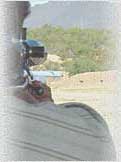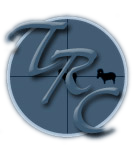Metallic Silhouettes
The Hunter's Game
The Mexicans first called it, Siluetas Metalicas, in English, Metallic Silhouettes. There are many variations of Metallic Silhouette shooting in extant today, but they all have one thing in common: metallic targets consisting of game
animal silhouettes placed at varying distances from the shooter.
Siluetas Metalicas began South of the border in the 1940's and was derived from an old hunter's game (story has it that before the use of metallic animal figures, live animals were staked out and shot). The first informal siluetas metalicas competition arranged by Don Gonzalo Aguilar, took place in Mexico City in 1948. The shooting sport of Siluetas Metalicas spread quickly with the first national championships held in Mexico City in 1952. At that time, the sport was mainly for high power rifles and consisted of thirty shots; ten each at gallina (chicken) at 200m, guajalote (turkey) at 385m, and borrego (sheep) at 500m.
Roy Dunlap, the father of High Power Rifle Silhouette shooting in the United States, led the effort to build the first formal silhouette range at the Tucson Rifle Club.
The shooting sport has evolved from a relatively simple hunter's game in Mexico using high power rifles to encompass matches which use pistols, air guns, smallbore and black powder (cartridge only) rifles. Today, Metallic Silhouette is used in a generic sense to describe all shooting using targets of metal shaped like game animals.
The Mexicans worked on a set of regulations for conducting Metallic Silhouette competition to achieve uniformity of conditions in their various range locations—the size and type of the silhouettes, height of stands, range distances, shooting equipment allowed and match operation procedures, were all first developed by our neighbors to the South. By 1960, the Mexicans had Siluetas Metalicas organized in Northern Mexico and formed La Liga del Norte (The Northern League).
In 1967, informal competition began in Nogales and other small Southern Arizona towns and the javelina (pig) at 300m was added. In that same year, Roy Dunlap, the father of High Power Rifle Silhouette shooting in the United States, led the effort to build the first formal silhouette range at the Tucson Rifle Club. The first formal silhouette competition North of the border was held at Tucson Rifle Club on April 18, 1968.
All shooting is done offhand without slings or shooting jackets.
 Usually the shooter has a spotter to advise on where the shot hit. The shooter is given 2-1/2 minutes to engage a bank of five silhouettes (five chickens, pigs, turkeys, or sheep, one shot each, left to right). Scoring is equally simple; if your shot knocks the target completely off its stand, it's a hit. Anything else is a miss. Move on to the next silhouette in the bank.
Usually the shooter has a spotter to advise on where the shot hit. The shooter is given 2-1/2 minutes to engage a bank of five silhouettes (five chickens, pigs, turkeys, or sheep, one shot each, left to right). Scoring is equally simple; if your shot knocks the target completely off its stand, it's a hit. Anything else is a miss. Move on to the next silhouette in the bank.
When the shooter has finished the first string of five targets, they are reset and a second string of five targets (of the same animal) is engaged. A match consists of ten gallina (chicken) targets at 200 meters, ten javelina (pig) targets at 300 meters, ten guajalote (turkey) targets at 385 meters, ten borrego (sheep) targets at 500 meters and has a maximum score of 40 points. The object of the competition is to knock over as many targets as you can, using only one shot per target, shooting in the prescribed sequence, within the prescribed time.
Smallbore Rifle Silhouette was brought to Tucson Rifle Club in 1977, by long time club member, Wayne Leek.
Shooters may compete in either (or both) of two rifle classes: Standard Class or Hunter Class. A Standard Class rifle must weigh 10.2 lbs. or less, and can be a custom rifle. A Hunter Class rifle must weigh 9 lbs. or less and must be an off-the-rack rifle or near to one (e.g., original stock, or a very close reproduction thereof, and the original trigger—set at a minimum of 2 lbs). And yes,
most shooters use scopes—usually in the range of 16x-36x. The scopes usually have parallax adjustments and target knobs.
A classification system exists so shooters compete against shooters of the same ability. Beginning shooters need not shoot against master class shooters. Everyone has a chance win his or her class. Classes are Master, AAA, AA, A, and B.
The use of smallbore (.22RF) rifles in silhouette shooting is achieved by using a scaled down version of the High Power Rifle Silhouette match. It is fired at one-fifth scale targets at one-fifth scale distances of those used in High Power Rifle Silhouette. In the smallbore version, the reduced size chickens are placed at 40 meters, pigs at 60 meters, turkeys at 77 meters, and sheep at 100 meters.
Smallbore Rifle Silhouette was brought to Tucson Rifle Club in 1977, by long time club member, Wayne Leek. Leek first developed the idea of Smallbore Silhouette while living in New York State because real estate prices there were too high to permit him to build a full size High Power Rifle Silhouette range.
State, National, and International Silhouette Championships in High Power Rifle and Smallbore Rifle are still held at Tucson Rifle Club.
As High Power Rifle Metallic Silhouette shooting increased in popularity, handgun shooters became interested too. Pistol shooters began to hold silhouette matches and develop their own rules. The International Handgun Metallic Silhouette Association (IHMSA) was organized in 1976 to promote handgun silhouette competition.
Handgun Silhouette shooters, Big Bore (IHMSA) & Long Range (NRA) classes, use the same animal silhouettes as in High Power Rifle, only set at distances from 50 to 200 meters. Field Pistol (IHMSA) & Hunter Pistol (NRA) classes use 3/5 sized silhouettes at shorter distances. There is even an Air Gun pistol class with smaller targets at shorter distances.
Tucson Rifle Club sponsored the country's first Metallic Silhouette Pistol match September 20-21, 1975.
 Pistol Silhouette shooting has now become almost as popular and widespread as High Power Rifle Silhouette in the United States. State, National, and International Silhouette Championships in High Power Rifle and Smallbore Rifle are still held at Tucson Rifle Club.
Pistol Silhouette shooting has now become almost as popular and widespread as High Power Rifle Silhouette in the United States. State, National, and International Silhouette Championships in High Power Rifle and Smallbore Rifle are still held at Tucson Rifle Club.
Both High Power Rifle and Handgun Silhouette match rules have provisions and classifications for physically challenged competitors. It is not unusual to see shooters on crutches or in wheelchairs competing at these matches.
For shooters who abhor delayed gratification, this is the sport for you. One does not wait to see and score his target as in disciplines involving paper. A hit results in a resounding clang and a metal target toppling from its stand. A miss, and only a puff of dirt kicks up behind the target. Competitors and spectators alike can view the action and share in the results!
